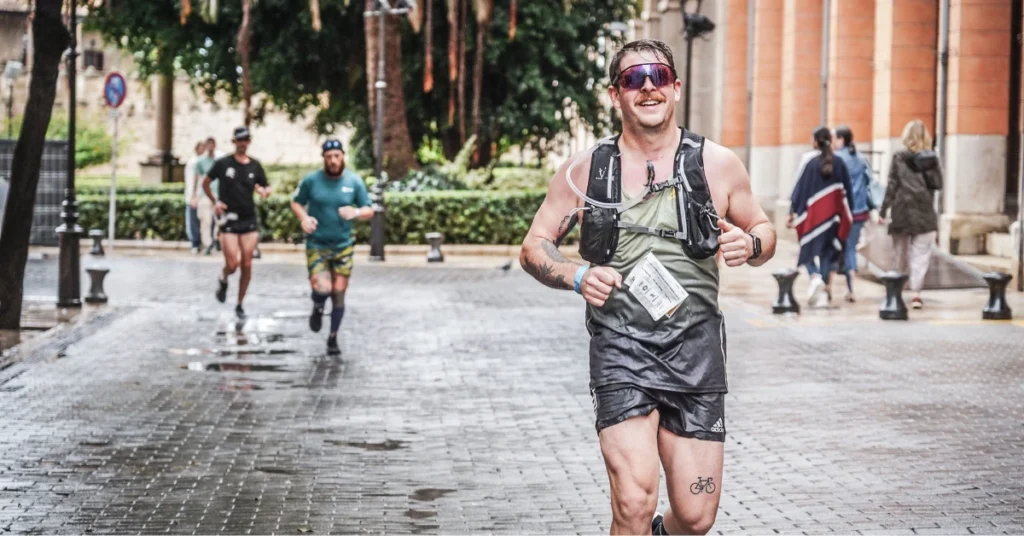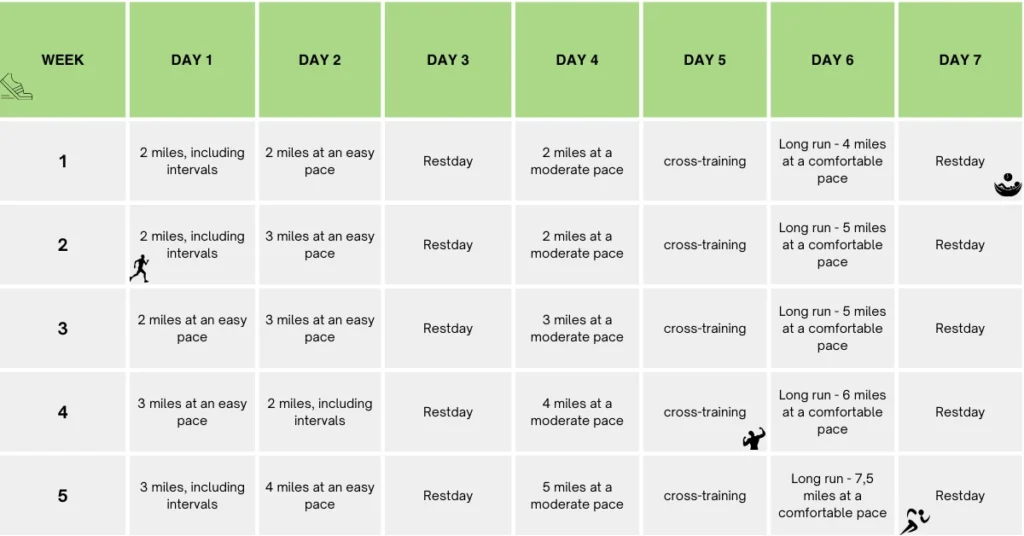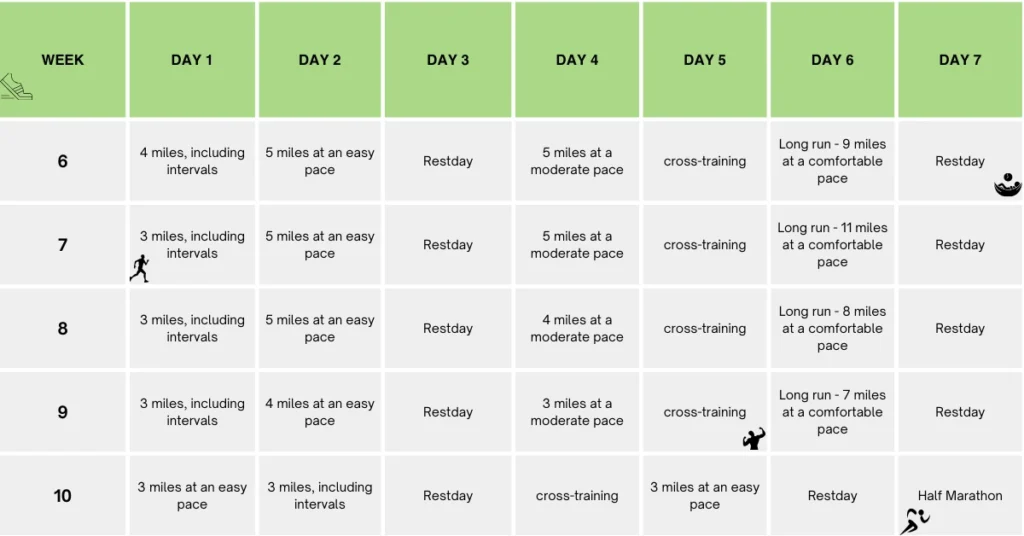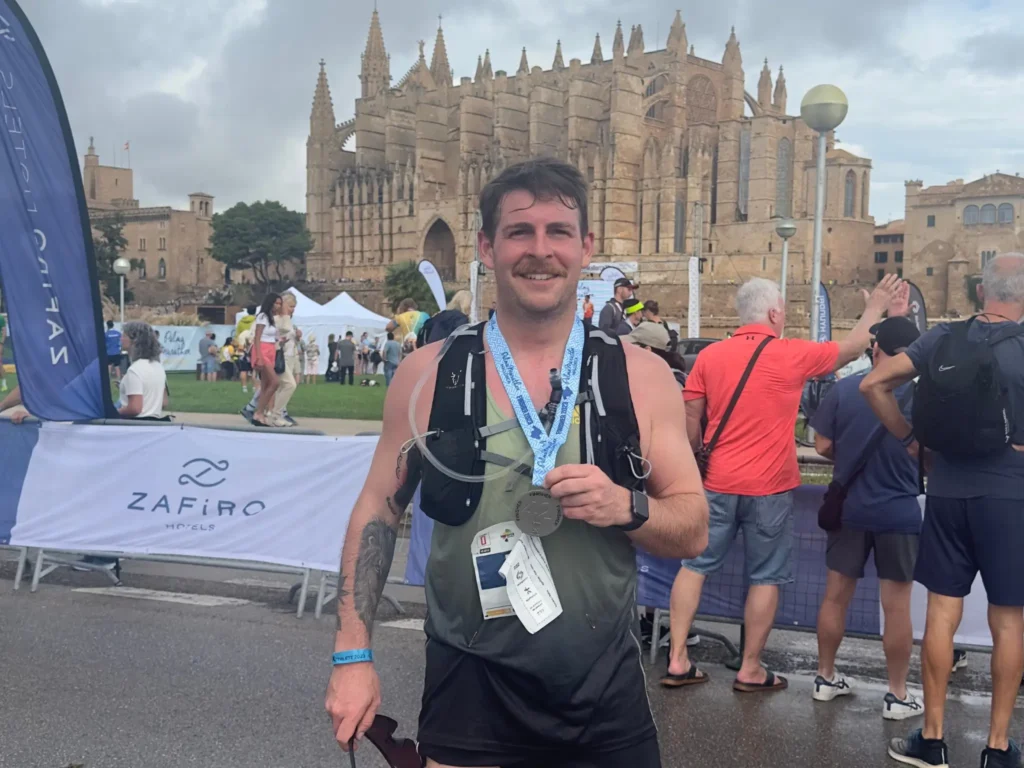Training for a half marathon in 10 weeks is an achievable goal for runners of all levels. Our tailored 10 week half marathon training plan focuses on increasing endurance, improving pace, and ensuring race readiness. With flexibility in intensity and mileage, our 10 week half marathon training plan is designed to minimize injury risk and maximize strength. Consistency, a mix of running and cross-training, and a supportive community will guide us to success on race day. Let’s conquer those 13.1 miles together!
Pro´s:
- ✅ High Precision & Powerful Navigation Systems
- ✅ 150plus Sports Modes & 5 ATM Water Resistance
- ✅ Alexa Built-In & Offline Assistant
Con:
- ❌ Extra weight when running
Setting Your Goals
Before we dive into the meat of our 10 week half marathon training plan, let’s clarify what we’re aiming for. This involves setting clear and achievable finish line goals, as well as understanding the time and pace necessary to get us there.
By doing this, we’re not just training blindly; we’re working towards a tangible outcome on race day.
🏁 Determining Your Finish Line Objectives
When we talk about finish line objectives, we’re considering what we want to accomplish by the end of our 10-week half marathon journey.
Are we looking to simply cross the finish line, or are we aiming for a more specific time goal, like a sub 2 hour half marathon?
Our goals might look like this:
- To finish the race, regardless of time
- To achieve a personal best
- To maintain a consistent pace throughout
Let’s list some potential goals to consider:
- Completion: Finishing the race, regardless of our time.
- Time-specific: Aiming for a completion time, such as under 2 hours.
- Pace-focused: Keeping a steady pace, like maintaining 9 minutes per mile.
It’s important for us to set realistic and measurable goals.

“I advise you to set goals. Your head and your mind find it easier to support your body when it has something to cling to. You automatically run better.”
⌚ Understanding Time and Pace
Time and pace are two peas in a pod when it comes to running a half marathon.
Here’s a simple breakdown of what time and pace might mean for us:
- Pace: The minutes it takes to run one mile.
- Time: The overall duration it takes to complete the half marathon.
If we’re aiming for a sub 2 hour half marathon, then our pace needs to be approximately 9 minutes and 9 seconds per mile.
- ⌚ Of course, this should be adjusted according to how our body responds during training.
- ⌚ We should plan our pace so that we’re not starting too fast and risking exhaustion, nor too slow and missing our target time.
- ⌚ By breaking down our overall time goal into pace per mile, we make the target much more manageable and less daunting.
- ⌚ Our training runs should thus reflect the pace we hope to maintain on race day, allowing our bodies to adapt to the rhythm and endurance required.
Consistent practice will help us find and stick to our ideal pace.
Creating Your 10 Week Half Marathon Training Plan
Here is part 1 of our 10 Week Half Marathon Training Plan:

And here is part 2 of our 10 Week Half Marathon Training Plan:

When we embark on a 10 week half marathon training plan, our goal is to build up weekly mileage safely and incorporate various types of runs that improve our speed and endurance.
🏃♂️ Weekly Mileage and Long Runs
Building Mileage: The structure of our 10 week half marathon training plan should allow for gradual increases in our weekly mileage. This is essential to avoid injury and promote steady progress.
Long Runs: Our weekend runs are the cornerstone of our training schedule, featuring progressively longer distances.
These long runs build our stamina and train our body to endure the demands of the 13.1-mile distance.
Aim to add 1-2 miles to our longest run each week, peaking two weeks before the race.
🏁 Incorporating Speed and Tempo Work
Speed Work: To improve our speed, we include interval training in our regimen.
- Interval training involves short bursts of high-intensity running followed by periods of recovery.
- For example, we might sprint for 400 meters and then walk or jog for 400 meters to recover, repeating this pattern multiple times
Tempo Runs: Another key component is the tempo run, which helps us develop our anaerobic threshold.
- A tempo run is typically a sustained effort at a challenging but manageable pace.
- We might execute a tempo run by starting with a one-mile warm-up, followed by three miles at a tempo pace, and concluding with a one-mile cool-down.
By blending long runs, speed work, and tempo runs into our 10 week half marathon training plan, we can approach race day with confidence in our ability to complete a half marathon.
Building Core Strength and Endurance

In our 10 week half marathon training, focusing on core strength and endurance is pivotal.
We’ll incorporate specific exercises and cross-training activities to ensure we’re building a robust foundation.
🏋️♀️ Strength Training Essentials
For our core and overall strength, we can’t overlook the importance of targeted exercises.
Squats and lunges are vital for our leg and glute strength, directly impacting our running efficiency. Include these exercises:
- Squats (3 sets of 12 reps)
- Lunges (3 sets of 10 reps each leg)
- Planks (3 sets of 30 seconds to 1 minute)
We should also integrate core-specific exercises like planks to improve our stability and endurance. This helps us maintain proper running form, even when fatigue sets in.
🚴 Cross-Training Activities
Cross-training is a fantastic way to build endurance without the high impact of running.
We can include low-impact activities like cycling or swimming that elevate our heart rate and build aerobic fitness. Here’s a simple weekly plan to get us started:
- Cycling: 30 minutes at a moderate pace
- Swimming: 30 minutes focusing on continuous laps
Incorporating yoga or pilates can also be beneficial, offering both strength and flexibility gains while also providing valuable recovery for our muscles.
These activities should be part of our routine at least once a week to optimize our 10 week half marathon training benefits.
Nutrition and Hydration

As we embark on our 10 week half marathon training, it’s crucial for us to focus on a strategic combination of nutrition and hydration for peak performance. Let’s dive into the specifics of what to eat and how to ensure we stay properly hydrated.
🍽 Eating for Performance
Our fuelling strategy for the half marathon begins with a balanced diet that emphasizes complex carbohydrates, lean proteins, and healthy fats.
Complex carbohydrates are our main source of fuel, so we’ll want to include foods like whole grain pastas, brown rice, and quinoa. They provide the steady energy we need for long training runs.
- Complex Carbohydrates: Whole grains, legumes, fruits
- Lean Proteins: Chicken breast, tofu, fish
- Healthy Fats: Avocados, nuts, seeds
Incorporating lean proteins helps with muscle repair and recovery, while healthy fats support overall health.
💧 Staying Hydrated
Hydration isn’t just about drinking water; it’s about ensuring we maintain a balance of electrolytes too.
During training, we lose electrolytes through sweat, so we must replenish them.
- Pre-Run: Drink 17-20 ounces of water 2-3 hours before running
- During Run: Sip 7-10 ounces of water every 10-20 minutes
Our hydration strategy should include water and possibly an electrolyte beverage during longer runs.
It’s best to avoid caffeinated or sugary drinks as they can lead to dehydration.
Our bodies can’t perform at their best when they’re dehydrated. So let’s keep a water bottle handy and sip consistently throughout the day, not just during our runs.
🛌 Strategic Rest Days
Why we need them:
Rest days are essential because they allow our muscles to repair and rebuild.
By planning for regular rest days, typically once or twice a week, we can reduce the risk of overtraining and injuries.
When to schedule them:
- Sunday: After a Saturday long run, a day off helps with recovery.
- Wednesday: Before the weekend’s longer distance, resting can ensure we’re primed for the effort.
🧘 Active Recovery Techniques
What it involves:
Active recovery refers to simple, gentle activities that improve circulation, which can help speed up the healing process.
These activities are not meant to be strenuous but rather to keep the body moving on days off from running.
Examples of active recovery:
| Activity | Benefits |
|---|---|
| Yoga | Increases flexibility and reduces stress |
| Swimming | Low-impact workout that soothes sore muscles |
| Walking | Boosts blood flow without straining the joints |
Incorporating these approaches into our 10 week half marathon training regimen will not only aid in healing but may also enhance overall fitness.
Let’s prioritize our rest and recovery just as much as our running days—it’s the balance that creates a sustainable and successful training plan.
Running Gear and Apparel

Selecting the right equipment can greatly enhance our comfort and performance during the 10 week half marathon training. Let’s get into the specifics of the gear we’ll need.
🏃 Choosing the Right Running Shoes
Our running shoes are the most critical piece of gear we’ll choose; they’re the workhorses of our entire training.
When selecting shoes, consider factors like cushioning, stability, and your individual running style.
We’ve got to ensure they fit perfectly and provide the support we need for those long training runs.
Consider visiting a specialty store to get a proper fitting or research for shoes specifically designed for your gait and any foot conditions you may have.
🎽 Essential Gear for Training
Apart from our trusty running shoes, we’ll need a few more items to complement our training:
- Clothing: Breathable and moisture-wicking fabrics are our best friends. Think lightweight and layer-able for varying weather.
- Socks: Invest in quality running socks that prevent blisters and provide cushioning.
- Hydration Pack/Belt: Staying hydrated is non-negotiable, so a good hydration system should be on our list.
- Running Watch/GPS Tracker: To track our progress, a watch or app that records distance and pace can be incredibly helpful.
Selecting the right running shoes & gear can make all the difference in our training experience and help us reach the finish line with confidence.
Preparing for Race Day

In the final stretch before race day, our focus shifts to fine-tuning our bodies and minds. We need to implement a strategic taper and fortify our mental game, ensuring we’re both physically primed and mentally sharp for the challenge ahead.
🏃 The Tapering Process
The last few weeks before the race call for tapering, a reduction in our mileage to allow our bodies to rest and recover.
We start by scaling back our long runs and overall volume while maintaining a degree of intensity to keep our legs fresh.
Here’s a simplified outline for tapering:
- Week 1: Reduce weekly mileage by 20%
- Week 2: Cut weekly mileage by 30-40%
- Days leading up to the race: Keep runs short, 2-4 miles at most
During this time, it’s also crucial to prioritize sleep, nutrition, and hydration for optimal recovery.
💭 Mental Preparation & Strategy
Preparing our minds is just as important as our physical efforts. As we approach race day, let’s visualize the course and plan out our race strategy, including pacing, hydration stops, and energy gels.
We should also create a personal mantra for those tough moments, and familiarize ourselves with the course layout.
Our race strategy should include the following elements:
- Start: Begin at a comfortable pace; it’s easy to start too fast in the excitement.
- Middle: Settle into our target pace, stay focused and relaxed.
- Finish: Plan when to increase effort for the final push.
Injury Prevention and Management
Proper running form and addressing common injuries are key components in ensuring our half marathon training is not only effective but also safe. We aim to enable our bodies to handle the stresses of running while minimizing the risk of injury.
🏃 Maintaining Proper Running Form
First things first, we need to focus on proper running form to prevent injuries.
It’s essential to keep our back straight, shoulders relaxed, and gaze ahead.
We should also make sure our arms swing from the shoulder joint without crossing over the chest, and our hands are relaxed.
This is not just about the upper body; our foot strike plays a significant role too.
Landing mid-foot under our center of gravity allows for a smoother run and less impact that can lead to injuries.
If you’re unsure about your form, consider a professional assessment or utilize resources on proper running form.
🩹 Addressing Common Running Injuries
When it comes to common running injuries, awareness and early action are our allies. The sooner we address the twinges and aches, the better.
Runner’s knee, Achilles tendinitis, and shin splints are frequent unwelcome guests in our training.
We should incorporate strengthening exercises for the hips and core to help prevent these injuries.
Moreover, if we have an existing injury, we must manage it according to professional guidance – resting, icing, compressing, and elevating the affected area can help.
And remember, allowing time for recovery is just as crucial for our 10 week half marathon training as the miles we log.
Training Tips and Techniques

As we embark on our 10 week half marathon training, it’s crucial we understand and respect our body’s needs while remaining flexible in our approach. Here are some focused tips and strategies to help us train effectively and safely.
📈 Understanding Your Body’s Signals
Listen to your body: It’s essential to pay attention to what your body is telling you.
If you experience unusual pain or fatigue, it may be an indicator that you need to rest.
Incorporating easy runs at a comfortable pace allows us to recover and prepares our bodies for harder workouts ahead.
- Fatigue: Scale back on distance or pace when feeling overly tired.
- Pain: Persistent discomfort might require rest or medical attention.
- Recovery indicators: Things like heart rate and sleep quality can tell us if we’re recovering well.
🔄 Adjusting Your Training as Needed
Flexibility in training is key; not every plan fits perfectly with our unique lifestyles and bodies.
If we find a particular week too challenging, it’s okay to adjust our schedule.
Working with a running coach can be beneficial, as they can offer personalized training tips to improve our regimen.
- Missed Workouts: If we miss a day, we can adjust the rest of the week to accommodate it.
- Hard Work Pays Off: Incorporate varied intensities, but allow for rest to reap the benefits of our hard work.
Our Opinion on the 10 Week Half Marathon Training


We believe that a 10 week half marathon training plan can be a strong option for runners with a solid foundation who are short on time.
Such a plan typically offers a balanced approach, with a mix of long runs, tempo runs, and speed work.
Here’s how we see the components fitting together:
- Long Runs: Critical for endurance, we cap these at a manageable distance each week.
- Tempo Runs: Once a week, incorporating race pace or slightly faster efforts sharpens our speed.
- Speed Work: Intervals or track workouts that increase our leg turnover and improve efficiency.
We find that rest days are just as important as the training days, allowing our bodies to recover and prevent injury.
Strength training and cross-training are also integrated to improve overall fitness and resilience.
In our collective experience, this training structure brings out a desirable outcome for intermediate runners, especially those eying a new personal best.
However, it’s pivotal to start with a reliable base mileage – we shouldn’t jump into such an intense plan without proper preparation.
Ultimately, we recommend a 10 week half marathon training plan for those who can already comfortably run a 10K and maintain a regular running routine.
FAQ
How many days a week should I train for a half marathon?
Aim for 3-4 days of running, with 12 days of cross-training.
How long should my long runs be during training?
Gradually increase your long run distance, peaking around 10-12 miles.
Should I incorporate speed work into my training?
Yes, include intervals or tempo runs to improve pace and endurance.
What is your option for our 10 week half marathon training? I would love to hear it in the comments. I’m sure you also like reading about the best Amazon running shorts or about the best handheld water bottle for running.



